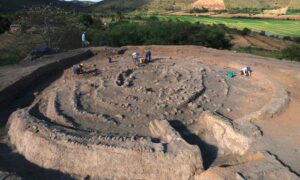Montegrande Peru is a significant archaeological site located in the Jequetepeque Valley. It’s known for its ancient temple complex, which dates back to the Formative Period of pre-Columbian history. The site gained attention for its monumental architecture and the discovery of a burial site, which included a cache of offerings and a female mummy. These findings suggest that Montegrande was a center of religious and ceremonial activities. The site provides valuable insights into the early development of complex societies in the Andes.
Cupisnique culture
The Cupisnique culture, a precursor to major Andean civilizations, flourished along what is now the northern coast of Peru, primarily in the Chicama, Moche, and Jequetepeque valleys, from approximately 1500 to 1000 BCE. This culture is considered one of the foundational societies in the Andean region, laying the groundwork for subsequent civilizations such as the Moche and the Chavín. The Cupisnique people were among the early adopters of ceramics in the Americas, a hallmark of their cultural identity and a key medium through which they expressed their religious beliefs and societal norms.
One of the major moments in the Cupisnique timeline was their development of complex irrigation systems, which allowed them to cultivate crops in the arid coastal plains. This agricultural innovation was a significant leap forward, enabling the Cupisnique culture to sustain a growing population and develop into a more complex society. Their ability to manipulate their environment is a testament to their ingenuity and foresight, characteristics that would be emulated by later Andean cultures.
Religion played a central role in Cupisnique society, with a pantheon of gods that were closely associated with natural elements and agricultural fertility. The most iconic religious artifact from this culture is the “Stirrup Spout Vessel,” which often depicted deities, animals, and mythical creatures. These vessels are believed to have been used in religious ceremonies, possibly involving the consumption of chicha (corn beer) or other psychoactive substances to facilitate communication with the divine. The Cupisnique also constructed monumental temples and pyramids, which served as centers for religious activity and community gatherings.
The social and daily life of the Cupisnique people was intricately tied to their agricultural calendar, with the majority of the population engaged in farming and animal husbandry. Artisans, particularly those skilled in ceramics and textiles, held a special place in society, as their crafts were essential for both daily life and religious ceremonies. The Cupisnique society was likely stratified, with a ruling class that oversaw religious activities, trade, and the distribution of resources.
There is little direct evidence regarding the rulers, kings, or queens of the Cupisnique culture, as writing systems had not yet been developed in the region during this period. However, archaeological evidence suggests that there were individuals of higher status, as seen in the elaborate grave goods found in certain burials. These individuals may have been leaders or priests who wielded significant power within their communities.
The Cupisnique culture originated in what is now the northern coast of Peru, a region characterized by its dry desert landscape and fertile river valleys. This geographic setting provided the Cupisnique with both challenges and opportunities, as they had to develop techniques to harness the limited water resources for agriculture while also taking advantage of the rich marine life along the coast.
While there is limited evidence of wars and battles involving the Cupisnique culture, conflicts over resources such as water and arable land may have occurred with neighboring groups. The construction of fortified structures and the presence of weapons in some archaeological sites suggest that the Cupisnique people were prepared to defend their communities if necessary.
The decline of the Cupisnique culture around 1000 BCE is not fully understood, but it is believed to have been a gradual process influenced by environmental changes, shifts in trade networks, and the emergence of new cultural practices. The legacy of the Cupisnique culture, however, lived on, influencing the development of subsequent Andean civilizations through their advancements in agriculture, ceramics, and religious practices. Their contributions to the Andean cultural heritage are a testament to the ingenuity and resilience of the Cupisnique people.

